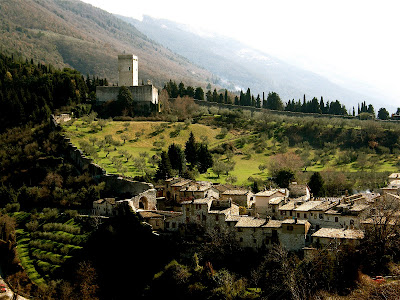


Shortly after arriving in Lausanne, we were on the highway to the ski village of Leysin. Situated on the "sunny side of the alps," Leysin has been dubbed "Oxygien des Alpes" because of the pure air that so many have sought out. Ironically, I wouldn't experience either of these catchphrases. With constant rain and fog, I never saw the sun. I also caught a really bad cold while there. Some are cured of their respiratory ailments from a weekend in Leysin. Others, like me, catch the ones that they lose.
But the weekend was far from a loss.
That night, we went to a traditional swiss restaurant. Though everyone in the family ordered pizza, they suggested that I order "roestis," or a swiss traditional recipe of hash browns and cheese. The goat cheese, served fried and heavily seasoned, quickly melts all over the vegetables and hash browns, forming a delightful dinner for anyone from the state of Wisconsin.

The next day I slept much later than I intended. The altitude, which approaches 2,000 meters at the top of the ski hill, causes those of us from lower altitudes to fall in to long, deep sleeps. When I woke up, there was a gourmet brunch set out for us- including traditional swiss breads and sausages. While comparisons on cultural superiority are generally biased, I think everyone would agree that the Swiss are far better than the Italians when it comes to breakfasts.


We eventually arrived at the slopes, where I baffled the rental staff with my enormous feet. Eventually they managed to find a boot size that fit. I was handed a pair of the nicest skis I've ever used. Though I forgot the brand, their shape and feel were indicative of something that nobody from Wisconsin would ever use to ski at Waupaca's "Nordic Mountain." Though the weather was not cooperating (heavy rain, wind and fog) the runs remained open. I was given a tour of the mountain, on which we passed igloos, rotating restaurants, lakes, buried houses, beware of avalanche signs, and an enormous glacier in the distance. As we skiied past the enormous glacier, I was reminded of a tour I gave to a group of 4th grade fundamentalists- whose teacher kindly reminded me not to mention glaciers, as they didn't believe in them. I have to admit, I was skeptical about the existence of glaciers from that day on. But now that I have skiied besides one- I think I have to affirm their existence as all too real.



I found it interesting that the trails did not have names. Instead, they had a number and an arrow pointing to one of the three towns that are accessible from the mountain. This means that one trail takes up to fifteen minutes to complete, more if you stop to take pictures, or in my case, stop to take an embarrasing fall every few runs.
In the end, the "temps du merd" could not detract from the natural beauty of the alps. We finished the day with a dinner at "Le Fromagerie," a traditional swiss fondue restaurant. I committed the mortal sin of dropping a piece of bread in to the cheese- as a result, I was forced to "run" 3 laps around the restaurant. I also learned that whoever drops their food in the fondue pot automatically picks up the check- harsh rule when you're with 8 other people (they waved this statute for me, citing my Americanness).
The next day featured more bad weather, but more great food. After another brunch of swiss bakery goods, we descended the slopes via car and returned to Lausanne (because of the altitude change and my cold, I would not be able to hear for the remainder of the trip). Lausanne is home to the International Olympic Movement, and the Olympic Museum. A perfect rainy day activity for the avid sports fan, and a nice change of pace from the Uffizi. It was like being in a cosmopolitan Packer hall of fame.
Though the weather was bad, the Badgers lost, I only got to ski for a few hours- I had one of the best weekends of my semester. In 30 some days, I will be returning to Lausanne to see more of the beautiful sights that Switzerland has to offer.
MOVIE RECOMMENDATION: "Cinema Paradiso", a 1988 Italian film directed by Giuseppe Tornatore. Definitely has moved onto my list of all time favorites. A must watch for.... people.







































